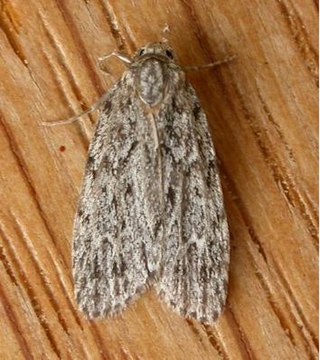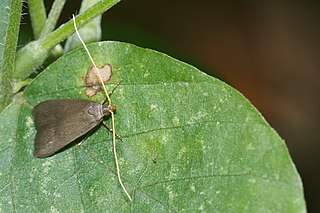
Halone is a genus of moths in the subfamily Arctiinae from southern Asia and Australia. The genus was erected by Francis Walker in 1854.

The Lecithocerinae are a subfamily of small moths in the family Lecithoceridae. They are found worldwide, but most species occur in South Asia. The subfamily is characterized by the male genitalia with a bridge-like structure connecting the tegumen and the valva, and the uncus almost always is vestigial with two lobes at the dorsal base, only exceptionally united into a broad plate, but never as a thorn or spine.

Eudonia is a large and widespread genus in the grass moth family (Crambidae), subfamily Scopariinae. There is no common name for the roughly 250 species placed here; new species are still being described regularly. Although the genus was proposed early in the 19th century, many of these moths were for a long time retained in Scoparia, the type genus of the subfamily and a close relative of Eudonia. A few small genera have been proposed for separation from Eudonia, but given the size of this group this is not particularly convincing; thus, all are retained here pending a comprehensive phylogenetic review.
Frisilia is a genus of moths in the family Lecithoceridae. The genus was erected by Francis Walker in 1864.
Frisilia homalistis is a moth in the family Lecithoceridae. It is endemic to Taiwan.
Frisilia crossophaea is a moth in the family Lecithoceridae. It is found in Sikkim, India. Only holotype, a female, is known.

Gelechiinae is a subfamily of moths in the family Gelechiidae. It was described by Henry Tibbats Stainton in 1854.
Frisilia compsostoma is a moth in the family Lecithoceridae. It was described by Edward Meyrick in 1921. It is found in the Democratic Republic of the Congo's former Katanga Province and in Zimbabwe.
Frisilia melanardis is a moth in the family Lecithoceridae. It was described by Edward Meyrick in 1910. It is found on Borneo.
Frisilia procentra is a moth in the family Lecithoceridae. It was described by Edward Meyrick in 1916. It is found in southern India.
Frisilia senilis is a moth in the family Lecithoceridae. It was described by Edward Meyrick in 1910. It is found in southern India.
Frisilia strepsiptila is a moth in the family Lecithoceridae. It was described by Edward Meyrick in 1910. It is found in southern India.
Frisilia sulcata is a moth in the family Lecithoceridae. It was described by Edward Meyrick in 1910. It is found in Nepal and Assam, India.
Frisilia verticosa is a moth in the family Lecithoceridae. It was described by Edward Meyrick in 1914. It is found in southern India.
Frisilia dipsia is a moth in the family Lecithoceridae. It was described by Edward Meyrick in 1910. It is found in Sri Lanka.
Frisilia heliapta is a moth in the family Lecithoceridae. It was described by Edward Meyrick in 1887. It is found in Sri Lanka.
Frisilia notifica is a moth in the family Lecithoceridae. It was described by Edward Meyrick in 1910. It is found in Sri Lanka.
Frisilia rostrata is a moth in the family Lecithoceridae. It was described by Edward Meyrick in 1906. It is found in Sri Lanka.
Frisilia homochlora is a moth in the family Lecithoceridae. It was described by Edward Meyrick in 1910. It is found in southern India and Jiangxi, China.



